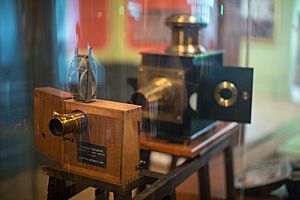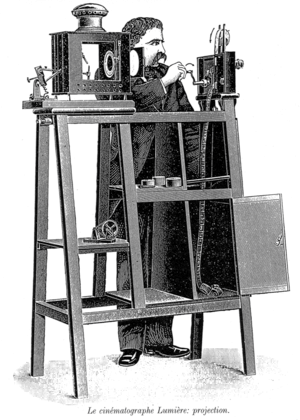Cinematograph facts for kids

The Cinematograph (say "sin-eh-MAT-oh-graf") was an early machine used to show movies. It could work as a movie camera to film things, a movie projector to show films on a screen, and even a way to make copies of films. This invention was very important in starting the movie industry!
Contents
History of the Cinematograph
The name "Cinematograph" was first used by a French inventor named Léon Bouly. He patented a device with this name on February 12, 1892. Bouly created the word from Greek words that mean "writing in movement." Unfortunately, Bouly did not have enough money to keep his patent.
Because of this, the famous Lumière brothers were able to use the name. In 1895, they used it for their own amazing invention.
The Lumière brothers made their very first film, Workers Leaving the Lumière Factory, in 1895. The first public showing of films happened on May 20, 1895, in New York City. This was with a machine called the "Eidoloscope". Many people often mistakenly think the first public showing was by the Lumière brothers. Their first public show was on December 28, 1895, in Paris.
This Paris show featured ten short films. One of them was a new version of Workers Leaving the Lumière Factory. Each of these early films was about 17 meters (or 56 feet) long. When cranked by hand through a projector, they lasted about 50 seconds.
How the Cinematograph Was Invented

Louis Lumière and his brother Auguste worked together to create a motion-picture camera. They wanted it to be better than Thomas Edison's kinetograph. Edison's machine could not project images onto a screen for many people to watch.
The Lumière brothers wanted to fix the problems they saw in Edison's machines. They aimed to make a device with clearer images and better lighting. Their Cinematograph weighed only about 7 kilograms (16 pounds). This made it easy to carry and set up anywhere.
Also, the Cinematograph was operated by hand with a crank. Edison's camera used electricity, which made it harder to move around. Plus, only one person at a time could watch Edison's Kinetoscope through a small eyepiece. But the Cinematograph could project images onto a big screen. This meant a large audience could watch movies together!
The Cinematograph made very clear projected images. It had a special design where a fork-like part held the film frames in place behind the lens. It used tiny holes along the sides of the film strip to do this.
In 1897, the Lumières improved their invention even more. They used a glass flask filled with water as a lens. This helped focus the light onto the film and also absorbed heat. The flask also acted as a safety feature. If the glass broke from getting too hot, the light would no longer focus on the film, which could easily catch fire.
The Cinematograph's Popularity
After the Lumières' first successful public showing in 1895, the Cinematograph became very popular. People all over the world wanted to see it. The Lumière brothers took their machine to places like China and India. People from all walks of life enjoyed watching the films.
The Cinematograph was used to show movies in nickelodeons. These were early movie theaters where even people with little money could afford to watch. It was also shown at fairs and used as entertainment in vaudeville shows in Europe and the United States. While vaudeville was popular with working and middle classes, the Cinematograph also appeared in fancier places. There, it appealed to the artistic tastes of high society.
See also
- Bioscop
- Biograph
- Electrotachyscope
- Film
- Image
- Kinetoscope
- List of film formats
- Panoptikon
- Pleograph
- Praxinoscope
- Vitascope
- Zoopraxiscope



